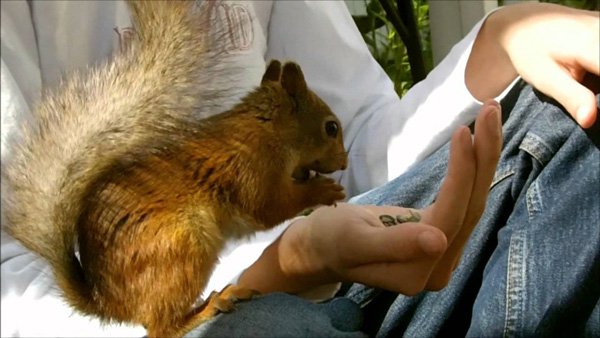Folks who adopt rescue dogs rarely know the dog's history. Was he completely abandoned? Did he ever bond with his former owner? Was he abused and therefore distrustful of humans? The point is, you'll never know if your newly adopted friend will suffer from separation anxiety until he's settled in and you start disappearing every day. So, it's best to be prepared should he begin to display all the classic symptoms.
Most of us are creatures of habit. And, that attribute is often displayed as we begin our morning "go to work" or "go to school" rituals. Make the coffee, get a shower, gather our keys, our briefcase or book bag, coat, hat, maybe warm up the car. Then, after all that, you're out the door and off. And your dog is left wondering when, even if, you'll walk through that door again. Panic takes over, which leads to severe anxiety, and some or all the classic symptoms - panting, nervous pacing, chewing anything in site, digging at the door to escape and catch up to you, incessant barking, whining, loss of bladder control.
Not a pretty state for your dog to be in day after day. And, it may not be a pretty state of your home upon your return.
I see no sense going into the causes of separation anxiety, since the treatment I have found to be successful and recommend you try would be the same regardless.
I suggest that you combine crate training with desensitization training. Both will require some effort on your part as well as your dog's, but the payoff will be well worth the time it takes to do it right. I ask that you refer to another article I posted on this Web site called - Rescue Dog Training - Crate Training is Kind not Cruel. In that article I explain the best methods for getting your dog acclimated to his crate to the point where he actually looks forward to time in his safe haven.
But, maybe it best I dedicate a few words on crating just to ease any guilt you may be feeling about "imprisoning" your dog in a steel wire box. Remember, your dog's ancestors and his modern day relatives in the Canedae family -- wolves and foxes -- use caves and dens to take refuge from danger or when they just need a quiet place to relax. Make your dog's "cave" large enough to stand and turn around and you'll find he will eventually wander in there on his own just for some peaceful downtime. Hopefully your hesitation to crate training as part of the cure for separation anxiety has been reduced. So, let's move on to desensitization or conditioning training.
Recall those rituals I listed above that you go through before you leave the house for an extended absence? Well, there is a real good chance your dog notices them to the point where he associates abandonment with those rituals. As soon as he notices your very first morning ritual, he may start to exhibit the classic symptoms of separation anxiety I listed earlier. Panting or barking, following you everywhere, or he may even disappear, preferring to hide until his anticipated fear becomes reality. At which point panic will take over.
Our objective with desensitization training will be to reverse the association your dog places on those morning rituals. We'll turn the negative associations into positive or at least neutral associations. [The techniques described below assume you have not yet gone through crate training, since its best to eliminate separation anxiety BEFORE crate training].
Start the very next weekend. Get up as though you were going about your weekday routine. Go through all the rituals. Never make a big fuss when you leave. Do not coddle the dog. Head out the door as you would Monday through Friday. Even start up your car. But this time, rather than drive away, you're going to wait five minutes and walk back into the house.
Don't make a big fuss, simply go get a treat to give your dog (after "sit") and a little bit of praise for being a good boy or girl. If time permits, do this several times each Saturday and Sunday until you begin to notice positive results. Each time increase the time by five or ten minutes. The purpose is to impress upon your dog that your leaving is not a forever thing and in fact it is a positive event (he gets a treat and some praise upon your return - whether it was five minutes or 8 hours).
Here's another tip that will help you achieve the end goal of calmness when you leave. Try to make a morning walk with your dog routine. Dogs that are well exercised spend more of their idle time resting rather than panicking. A morning walk will do you a world of good too I'll bet.
As soon as you notice that your dog is handling your departures much better with less stress and anxiety, start your crate training. Again, I ask that you refer to my article Rescue Dog Training - Crate Training is Kind not Cruel which will explain how to acclimate your dog to spending time in the crate.
It is recommended that you perform the same procedures as soon as you begin your crate training. Go through your normal morning routines, leave and then return 5 minutes later. Putter around the house a bit before you release your dog from the crate. Do NOT make a big fuss as he leaves the crate nor should you give him a treat at this moment. Otherwise, he'll perceive being out of the crate is better than being in the crate. Wait a few moments before you give him a treat and some petting and even a few "Good Boys". Do this routine on several consecutive weekends, and make your absence a little longer each time.
Eventually, because of your persistent desensitization and crate training, you'll be able to leave the crate door open and he will come and go as he pleases, knowing that you will eventually return.
A couple of closing comments. If you are away much longer than eight hours each day, you would be well advised to consider placing your dog in a doggie day care center. This will be good for your dog, and good for you knowing you will be picking up a happy, tired, well-adjusted pooch at the end of the day.
If you have an extreme case of separation anxiety, you may want to pursue vet prescribed medication. But I would make this a last resort. If you are consistent and patient with your training, you should meet with success.
Make sure you are a knowledgeable dog owner who has at his disposal excellent instruction that will help you correct any negative behavior your dog may exhibit during his long, happy life. Visit my site referenced below to review the two resources I found to be most useful.

 Recalled Food for Dog Has Been Declared Hazardous
Recalled Food for Dog Has Been Declared Hazardous
Recalled Food for Dog Has Been Declared Hazardous
Recalled Food for Dog Has Been Declared Hazardous
 How To Tell When To Interact With A Puppy, And When To Leave It Be
How To Tell When
How To Tell When To Interact With A Puppy, And When To Leave It Be
How To Tell When
 Chicken Runs: Here's a Shortlist of What to Expect When Buying
Chicken Runs: Here's a Shortlist of What to Expect Wh
Chicken Runs: Here's a Shortlist of What to Expect When Buying
Chicken Runs: Here's a Shortlist of What to Expect Wh
 Pet Cloning - Is It Viable And Ethical?
Pet Cloning - Is
Pet Cloning - Is It Viable And Ethical?
Pet Cloning - Is
 10 Things You Should Know Before Adopting A Degu
10 Things You Sho
10 Things You Should Know Before Adopting A Degu
10 Things You Sho